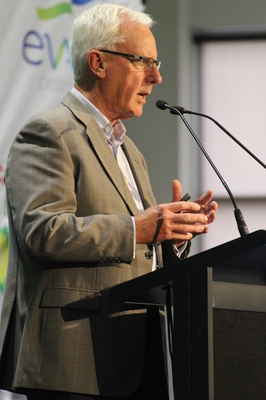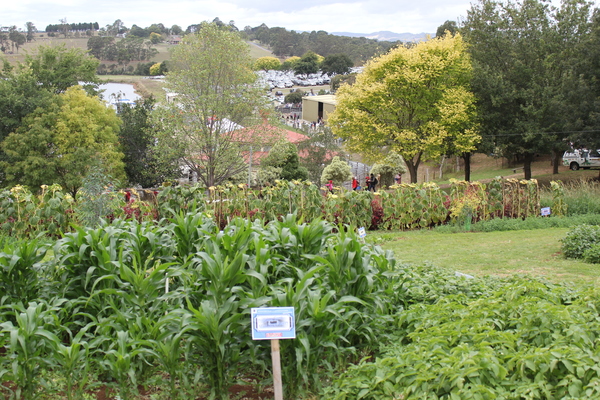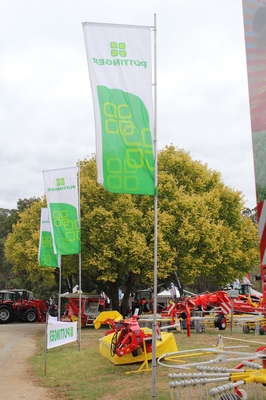By Russell Bennett
2017 marks a year of celebration for Warragul’s Lardner Park, with the 50th birthday of the famous Farm World event. The theme of Farm World this year was ‘Food and Fibre’ and recently RUSSELL BENNETT ventured along to hear a range of stories celebrating just how much the sector, and the event, means to Gippsland.
“In the days of Facebook, Instagram and the internet a lot of our customers will now turn up to the stand knowing more about a particular piece of equipment than we do!” – Nick Rowe
John Rogers has been a volunteer at Lardner Park for more than 50 years – pre-dating Farm World.
Now in his 80s, John had a simple answer when local west Gippsland identity Kevin Dale – who was the master of ceremonies for the official opening luncheon – asked him what the biggest changes he’d seen over that time were.
“The size of the machinery – it’s massive!” he said.
“Some of these things are 10-foot high and you need a massive shed to put them in.”
John Rogers also remembers when, in order to communicate with people in the various corners of the vast Lardner Park site, he had to ride a motorbike to go and speak with them face to face.
He’s seen more change than anyone over the past five decades, and keeps coming back to Lardner Park and Farm World year after year. He’s just one of many celebrating just what the facility, and the event, mean to the local area.
Graham and Nick Rowe of Vin Rowe Farm Machinery also spoke at the launch of this year’s Farm World event.
The pair represent the second and third generations of the Rowe family business – Graham is the son of founder Vin, while Nick is Graham’s son.
“My early memories are of the hotdogs and cups of tea you could buy at the first or second one,” Graham said.
“Now you can walk around and buy all sorts of things.”
Like John, Graham said the change in size of the event over the years marked the biggest difference.
Widely regarded as Victoria’s largest premier agricultural event, the four days of Farm World each year attract well over 50,000 visitors and more than 800 exhibitors, plus conference sessions, workshops, demonstrations, equestrian events, and other competitions.
“We come out here and we show our wares – we don’t demonstrate our wares – and we certainly have an organisation that is far more professional than it was in the old days,” Graham said.
“This is our opportunity to come here as retailers and show what we’ve got.”
The Vin Rowe name has been associated with a number of award-winning stands at Farm World over the years, and the event is crucial to the company.
“It’s a focal point of our year,” Nick said.
“We always talk about the field days, in the lead-up and afterwards.
“In the days of Facebook, Instagram and the internet a lot of our customers will now turn up to the stand knowing more about a particular piece of equipment than we do!
“It’s very easy to be caught out but I think that’s why it’s still important because it provides a casual setting for people to talk about the machines and not like they’re in a dealership having to buy something.
“I think people still really crave being able to go up to a tractor or harvester or something and touch it, see how tall it is, and ask questions about it.
“You could try and do as much of that as you like through the internet but it’ll never be a substitute for the actual thing.”
Robert Radford also spoke on the significance of Farm World, and Lardner Park more generally.
The managing director for the standard bearer in meat processing in Victoria – Radfords Warragul – Robert is also the vice chairman of the Australian Meat Industry Council, the president of Wholesale Butchers Credit Services, and a board member and past chairman of Lardner Park Events.
“I got involved in the late 1980s,” he said.
“It’s an agribusiness event so I got involved with that and then was asked to go on the committee, and 25 years later I’m part of the furniture here.
“It’s no different to being in Lions or Rotary – it’s a voluntary thing.
“You network with some really great people, and still a lot of these guys who’ve retired from the committees and boards are good friends of mine.
“It’s a great organisation and the infrastructure that we’ve put in here over the past 10 to 20 years speaks for itself. It’s been a real privilege to be part of the organisation.
“There are so many organisations that feed off the events out here, be they local schools, local sporting clubs who park cars and run raffles and support the movement of product around the site.
“I think that with our new CEO (Nicola Pero) coming on board, she’s got some great ideas. This is her first event so she’s putting her feet under the table.
“We’ve discussed some new ideas at board level over the past few months and some new events to utilise this.
“It’s our biggest asset, so we’re looking at more conferences, more outdoor events, health and fitness events, and some more music events, and to look at some low-cost accommodation on site.”
Ellinbank Football Club president Rob Pandolfo is one of the closest neighbours to Lardner Park. He explained the club’s involvement with the facility.
“The Ellinbank Football Club has been involved, mainly with the car parking,” he said.
“We’ve been growing that over the years – it’d be 30-plus at a minimum and it could even be 40. For most events we’ve been co-ordinating the car park effort and it’s been growing.
“Sponsorship is the lifeblood of any footy club – especially at a local level. We’re indebted to Lardner Park, its committee, and the whole organisation because of the stability of this.
“Ellinbank is very similar to Lardner – it’s just a hall, a school, and that’s about it.
“It’s a farming community and it has changed over the years. It was many, many, many families and now I think you could count the dairy farmers involved on just over one hand, so that’s changed significantly but it’s just been massive for the community.”
Agribusiness Gippsland chairman Paul Ford also addressed the official Farm World opening on the Friday, talking at length about the significance of the Food and Fibre sector.
“Way back, thousands of years back, there was an active food and fibre value chain operating in Gippsland and when you look at the history, people were gathering in areas where products were traded to talk about conditions and how bad the weather was,” he said.
“It was perhaps a forerunner to something like Lardner Park and Farm World thousands of years ago in the indigenous culture.”
In giving a real historical context, Paul spoke about a kind of ‘mobile Farm World’ operating in the area in the 1920s.
“This is a period when the soldiers were going back on to soldier settlement properties and they were quite difficult because the soldiers who were returning from the warfare in France were given an axe, a horse, a cow and 40 acres of bush to clear and turn into a prosperous agricultural area,” he said.
“They were struggling with that and the response was to have a mobile Farm World – a farming train, where there was about 10 carriages.
“Some had cattle, some were specialising in dairy or horticulture, and the train would pull up at stations.
They came up to the farm train to share ideas about what was tasked and look for new ways to get through those tough conditions and the change in the social and economic structure.”
And now, Food and Fibre is vital to the Gippsland region.
“You might not be aware that Gippsland is the largest of the nine regions (in Victoria) when you’ve got gross regional product,” Paul said.
“We’re at $15 billion per year in value add, Barwon around Geelong is about $12 billion, and then you drop to about $7 billion for some of the other regions, and the smaller regions are about $4 billion.
“It’s even more important because we’re closely linked geographically, socially, and economically to the south-east sectors of Melbourne.
“We’re the only region that has that close link into the peri-urban shires of Melbourne that are so important to us. It’s an advantage to Gippsland that no other reason has.
“It’s the biggest of the regions – it’s the economic driver of regional Victoria because there are nine regions and we’re producing 23 per cent of the gross regional product.
“When you add dairy, forestry products, meat, horticulture, and fishing together and you think of it as a supply chain rather than farming and labour separately – food and fibre processing – if you put it all as a chain together you’re looking at $7 billion of the $15 billion in Gippsland coming from food and fibre.
“It’s by far the most significant sector in the region.”











